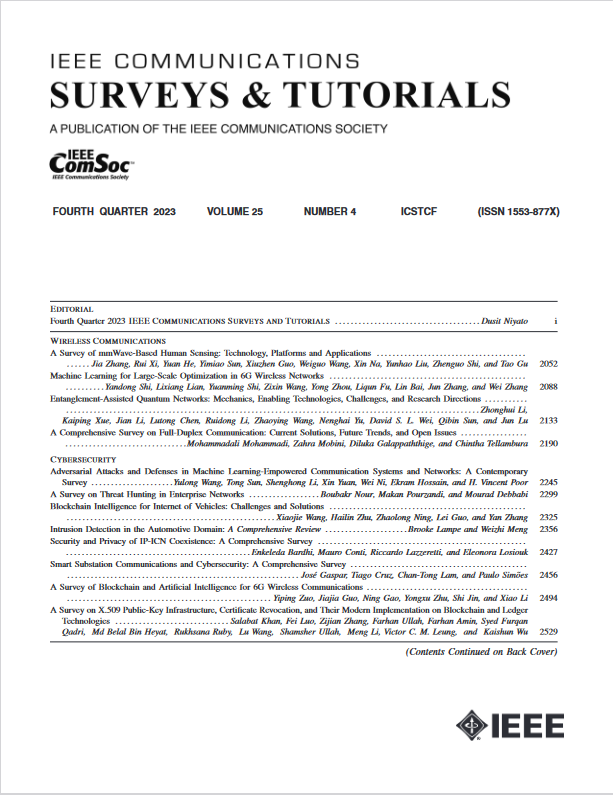Network Slicing-Based Learning Techniques for IoV in 5G and Beyond Networks
IF 34.4
1区 计算机科学
Q1 COMPUTER SCIENCE, INFORMATION SYSTEMS
引用次数: 0
Abstract
The effects of transport development on people’s lives are diverse, ranging from economy to tourism, health care, etc. Great progress has been made in this area, which has led to the emergence of the Internet of Vehicles (IoV) concept. The main objective of this concept is to offer a safer and more comfortable travel experience through making available a vast array of applications, by relying on a range of communication technologies including the fifth-generation mobile networks. The proposed applications have personalized Quality of Service (QoS) requirements, which raise new challenging issues for the management and allocation of resources. Currently, this interest has been doubled with the start of the discussion of the sixth-generation mobile networks. In this context, Network Slicing (NS) was presented as one of the key technologies in the 5G architecture to address these challenges. In this article, we try to bring together the effects of NS implications in the Internet of Vehicles field and show the impact on transport development. We begin by reviewing the state of the art of NS in IoV in terms of architecture, types, life cycle, enabling technologies, network parts, and evolution within cellular networks. Then, we discuss the benefits brought by the use of NS in such a dynamic environment, along with the technical challenges. Moreover, we provide a comprehensive review of NS deploying various aspects of Learning Techniques for the Internet of Vehicles. Afterwards, we present Network Slicing utilization in different IoV application scenarios through different domains; terrestrial, aerial, and marine. In addition, we review Vehicle-to-Everything (V2X) datasets as well as existing implementation tools; besides presenting a concise summary of the Network Slicing-related projects that have an impact on IoV. Finally, in order to promote the deployment of Network Slicing in IoV, we provide some directions for future research work. We believe that the survey will be useful for researchers from academia and industry. First, to acquire a holistic vision regarding IoV-based NS realization and identify the challenges hindering it. Second, to understand the progression of IoV powered NS applications in the different fields (terrestrial, aerial, and marine). Finally, to determine the opportunities for using Machine Learning Techniques (MLT), in order to propose their own solutions to foster NS-IoV integration.基于网络切片的学习技术,用于 5G 及其他网络中的物联网
交通发展对人们生活的影响是多方面的,从经济到旅游、医疗等。这一领域已经取得了巨大进步,并由此产生了车联网(IoV)概念。这一概念的主要目标是,依托包括第五代移动网络在内的一系列通信技术,通过提供大量应用,为人们提供更安全、更舒适的出行体验。拟议的应用具有个性化的服务质量(QoS)要求,这就为资源管理和分配提出了新的挑战性问题。目前,随着第六代移动网络讨论的开始,人们对这一问题的兴趣倍增。在此背景下,网络切片(NS)作为 5G 架构的关键技术之一被提出来应对这些挑战。在本文中,我们试图汇集 NS 在车联网领域的影响,并展示其对交通发展的影响。首先,我们从架构、类型、生命周期、使能技术、网络部分和蜂窝网络内的演进等方面回顾了 NS 在车联网领域的发展现状。然后,我们讨论了在这样一个动态环境中使用 NS 所带来的好处,以及所面临的技术挑战。此外,我们还全面回顾了 NS 在车联网学习技术各方面的部署情况。随后,我们介绍了网络切片在不同领域(陆地、空中和海洋)的不同车联网应用场景中的应用。此外,我们还回顾了车对物(V2X)数据集以及现有的实施工具,并简要总结了对物联网有影响的网络切片相关项目。最后,为了促进网络切片在物联网中的部署,我们为未来的研究工作提供了一些方向。我们相信,本次调查对学术界和产业界的研究人员都会有所帮助。首先,获得有关基于 IoV 的 NS 实现的整体视野,并确定阻碍其实现的挑战。其次,了解 IoV 在不同领域(陆地、空中和海洋)的 NS 应用进展。最后,确定使用机器学习技术(MLT)的机会,以便提出自己的解决方案,促进 NS-IoV 整合。
本文章由计算机程序翻译,如有差异,请以英文原文为准。
求助全文
约1分钟内获得全文
求助全文
来源期刊

IEEE Communications Surveys and Tutorials
COMPUTER SCIENCE, INFORMATION SYSTEMS-TELECOMMUNICATIONS
CiteScore
80.20
自引率
2.50%
发文量
84
审稿时长
6 months
期刊介绍:
IEEE Communications Surveys & Tutorials is an online journal published by the IEEE Communications Society for tutorials and surveys covering all aspects of the communications field. Telecommunications technology is progressing at a rapid pace, and the IEEE Communications Society is committed to providing researchers and other professionals the information and tools to stay abreast. IEEE Communications Surveys and Tutorials focuses on integrating and adding understanding to the existing literature on communications, putting results in context. Whether searching for in-depth information about a familiar area or an introduction into a new area, IEEE Communications Surveys & Tutorials aims to be the premier source of peer-reviewed, comprehensive tutorials and surveys, and pointers to further sources. IEEE Communications Surveys & Tutorials publishes only articles exclusively written for IEEE Communications Surveys & Tutorials and go through a rigorous review process before their publication in the quarterly issues.
A tutorial article in the IEEE Communications Surveys & Tutorials should be designed to help the reader to become familiar with and learn something specific about a chosen topic. In contrast, the term survey, as applied here, is defined to mean a survey of the literature. A survey article in IEEE Communications Surveys & Tutorials should provide a comprehensive review of developments in a selected area, covering its development from its inception to its current state and beyond, and illustrating its development through liberal citations from the literature. Both tutorials and surveys should be tutorial in nature and should be written in a style comprehensible to readers outside the specialty of the article.
 求助内容:
求助内容: 应助结果提醒方式:
应助结果提醒方式:


